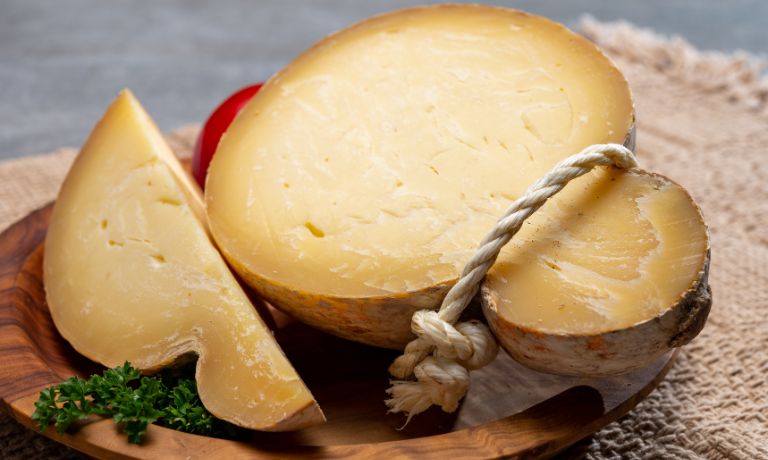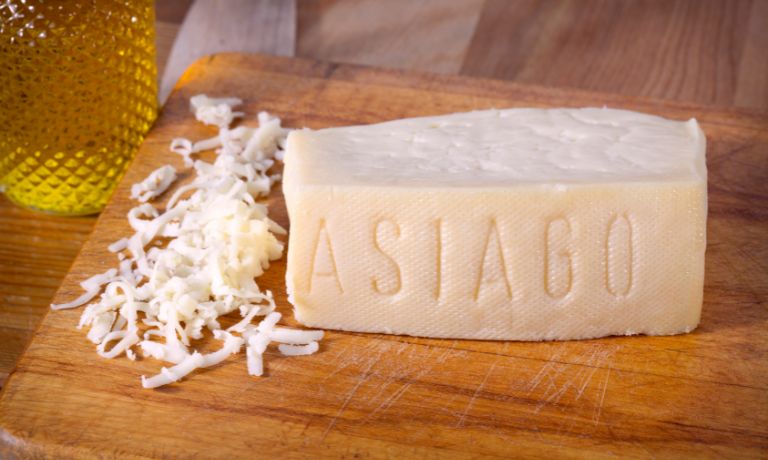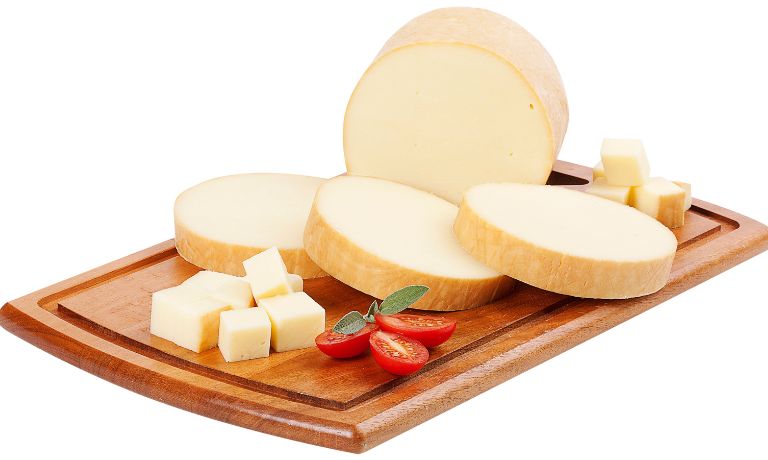Caciocavallo is a traditional Italian cheese defined by its distinctive flavor and texture.
Unfortunately, it’s hard to find in many parts of the world.
If this sounds familiar, you’re lucky – we have some ideal substitutes for caciocavallo!
Our simple recipe guide makes it easy to make your own version of traditional caciocavallo without sacrificing any flavor or texture.
Read on to see how you can make your delicious cheese replacement today!
What Is Caciocavallo Cheese?
Caciocavallo cheese is a stretched-curd cheese made from cow’s milk, traditionally produced in southern Italy.
It is shaped like a teardrop or pear, tied with strings due to its stretching technique.
The outside is yellow-brown, and the inside is white or straw-colored.
The flavor is salty but slightly sweet due to the high whey content.
Caciocavallo cheese can be eaten as a snack, grated over pasta dishes, or melted in recipes like lasagna and pizza.
It also pairs nicely with cured meats and robust red wines.
Due to its stretching technique, caciocavallo cheese is highly versatile and often used in many traditional Italian recipes.

Substitutes For Caciocavallo Cheese
Unfortunately, not everyone can get their hands on this traditional Italian specialty.
In these cases, several alternative options will give you the same flavors and textures.
Edam Cheese
Edam cheese is a semi-hard yellow cheese that originated in the Netherlands.
It is made from cow’s milk and has a mild flavor with nutty undertones.
The cheese has a smooth texture and can be used in many ways.
It pairs well with crackers, fruit, bread, and vegetables as an appetizer plate or charcuterie board.
Edam cheese can also be melted and used in many recipes, such as macaroni and cheese, grilled cheese sandwiches, or quesadillas.
The distinct flavor of Edam cheese makes it an excellent addition to salads or omelets.
Additionally, it is a popular snack when cut into cubes and served with crackers or fruit.
Many people enjoy Edam cheese as a dessert cheese, too. It pairs perfectly with sweet accompaniments such as honey or jams.

Asiago Cheese
Asiago cheese is a hard Italian cheese made from cow’s milk.
It is named after the town of Asiago, located in the northernmost province of Italy, near the Austrian border.
The flavor of Asiago cheese has been described as nutty and somewhat sweet with a slightly sharp taste.
Asiago cheese can be used in various dishes, such as lasagna, pizza, polenta and pasta.
It can also be eaten alone or with crackers as a snack.
This cheese is often grated over salads, mixed into scrambled eggs or used to top casseroles.
Asiago cheese melts well and can be used in various recipes that require melted cheese.
Some people even enjoy using Asiago cheese in desserts, such as ice cream or baked goods.
It can also make a delicious cheese spread with fresh fruits and vegetables.

Manchego Cheese
Manchego is a type of sheep’s milk cheese traditionally produced in the La Mancha region of Spain.
It is one of the most recognizable and popular Spanish cheeses.
Manchego has a slightly nutty flavor and firm texture, making it perfect for slicing or grating.
It can be used as an appetizer with olives, nuts or dried fruits, topping salads or soups, or melted onto toast.
Manchego is also a great addition to sandwiches and cheeseboards, providing an interesting flavor contrast to other cheeses.
Serve it with a glass of sherry for the perfect Spanish experience!

Gouda Cheese
Gouda cheese is a semi-hard cow’s milk cheese originating in the Netherlands.
It has a yellow to orange color and can range from mild to sharp in flavor.
Gouda is one of the most popular cheeses in the world and is used extensively in cooking.
It’s commonly melted on sandwiches, burgers, macaroni and cheese, and pizza.
Gouda also makes a delicious addition to salads, omelets, and soups or is even eaten as an appetizer.
It pairs well with fruits, nuts, crackers, and bread for an easy snack or light meal.
When melted over dishes like burgers or macaroni and cheese, it adds flavor and creaminess that can’t be beaten.

Provolone Cheese
Provolone cheese is a semi-hard, aged Italian cheese made from cow’s milk.
It has a mild, slightly smoky flavor that gets more pronounced with aging.
The texture of Provolone ranges from creamy to crumbly, and it can be found in various shapes such as pear, block, long logs and pyramids.
Provolone is most commonly used as a topping for pizza, sandwiches and salads.
It can also be melted to make sauces, toppings and fondues.
Grated Provolone is also popular in pasta dishes like lasagna and other casserole dishes.
It makes an excellent addition to cheesy omelets and frittatas, too.
Provolone cheese pairs well with cured meats like salami and prosciutto and with olives and artichokes.
It is also a great accompaniment to wines such as Pinot Grigio or Chianti.

Fontina Cheese
Fontina is an Italian cow’s milk cheese with a semi-firm texture and a nutty, buttery flavor.
It’s made from pasteurized or unpasteurized cow’s milk and has an orange-to-brown rind with small holes throughout.
Fontina is considered one of the best melting cheeses, making it a popular choice for cooking.
It’s commonly used in fondues, grilled cheese sandwiches, omelets, and quesadillas.
Fontina can be served as a table cheese or paired with cured meats, such as prosciutto and salami.
Its nutty flavor makes it an excellent addition to salads and pasta dishes.
Fontina is also often blended with other cheeses for a unique flavor combination.
It can be aged for several months to intensify its flavor and is available in grated and sliced forms.

Cheddar Cheese
Another option to substitute for Caciocavallo cheese is cheddar.
It is a hard, yellow-orange to white cheese made from cow’s milk. It can range in flavor from mild and mellow to sharp and tangy.
Cheddar has a firm texture that ranges from semi-soft to hard, depending on how long it has been aged.
This cheese originated in the English village of Cheddar, England and is now one of the most popular cheeses in the world.
Cheddar cheese is commonly used for slicing and melting sandwiches, burgers, wraps, and pizzas.
It can also be shredded in salads or added to quiches and soups.
Cheddar is a great way to add flavor to grilled cheese sandwiches, macaroni and cheese dishes, tacos, and casseroles.
Additionally, it can be grated, diced, or cubed as a topping for salads, potatoes, omelets, and even chili.

Parmesan Cheese
Parmesan cheese is a hard, dry cheese made from partially skimmed cow’s milk.
It has a salty, nutty flavor and is originally from northern Italy.
The texture of the cheese ranges from crumbly to granular, depending on its age.
It is most commonly used as a topping for pasta, salads, and soups.
This cheese is also used as an ingredient in many dishes such as risotto, pesto, minestrone soup, and macaroni and cheese.
It can be grated or shaved over foods to add flavor or used to make sauces creamier.
Parmesan cheese pairs well with vegetables like broccoli, mushrooms, artichokes, and Brussels sprouts.
Parmesan cheese can also be served as part of a charcuterie board with bread, crackers, cured meats, and fruits.
It is an addition to scrambled eggs or omelets for breakfast, potatoes au gratin for lunch or dinner, or even sprinkled over popcorn for a protein-packed snack.

FAQs
Can Mozzarella Replace Caciocavallo Cheese?
Yes, mozzarella can be used as a replacement for caciocavallo cheese.
Mozzarella is much milder in flavor than caciocavallo but it still provides a creamy texture and plenty of melty goodness.
Can Pecorino Romano Replace Caciocavallo Cheese?
Yes, Parmigiano Reggiano can be used as an alternative to Caciocavallo cheese.
The two cheeses have similar flavors and textures, so they work well together in recipes.
Can Parmigiano Reggiano Replace Caciocavallo Cheese?
Yes, Pecorino Romano is a hard cheese that can easily be used as a replacement for Caciocavallo.
It has a salty flavor and is made from sheep’s milk or cow’s milk, depending on the region it comes from.
Conclusion
Caciocavallo cheese is a semi-hard Italian cheese made from cow’s milk.
It has a salty, slightly sweet flavor and a firm texture that makes it ideal for slicing or grating.
Unfortunately, this cheese can be difficult to find outside of Italy.
Asiago, Manchego, Gouda, Provolone, Fontina, Cheddar, and Parmesan cheeses all make excellent options to substitute for Caciocavallo cheese.
Each of these cheeses has its own unique flavor profile that can bring something new to your favorite recipes.

